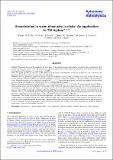Uncertainties in water chemistry in disks : an application to TW Hydrae
Abstract
Context. This paper discusses the sensitivity of water lines to chemical processes and radiative transfer for the protoplanetary disk around TW Hya. The study focuses on the Herschel spectral range in the context of new line detections with the PACS instrument from the Gas in Protoplanetary Systems project (GASPS). Aims. The paper presents an overview of the chemistry in the main water reservoirs in the disk around TW Hya. It discusses the limitations in the interpretation of observed water line fluxes. Methods. We use a previously published thermo-chemical Protoplanetary Disk Model (ProDiMo) of the disk around TW Hya and study a range of chemical modeling uncertainties: metallicity, C/O ratio, and reaction pathways and rates leading to the formation of water. We provide results for the simplified assumption of Tgas = Tdust to quantify uncertainties arising for the complex heating/cooling processes of the gas and elaborate on limitations due to water line radiative transfer. Results. We report new line detections of p-H2O (322-211) at 89.99 μm and CO J = 18-17 at 144.78 μm for the disk around TW Hya. Disk modeling shows that the far-IR fine structure lines ([O I], [C II]) and molecular submm lines are very robust to uncertainties in the chemistry, while the water line fluxes can change by factors of a few. The water lines are optically thick, sub-thermally excited and can couple to the background continuum radiation field. The low-excitation water lines are also sensitive to uncertainties in the collision rates, e. g. with neutral hydrogen. The gas temperature plays an important role for the [O I] fine structure line fluxes, the water line fluxes originating from the inner disk as well as the high excitation CO, CH+ and OH lines. Conclusions. Due to their sensitivity on chemical input data and radiative transfer, water lines have to be used cautiously for understanding details of the disk structure. Water lines covering a wide range of excitation energies provide access to the various gas phase water reservoirs (inside and outside the snow line) in protoplanetary disks and thus provide important information on where gas-phase water is potentially located. Experimental and/or theoretical collision rates for H2O with atomic hydrogen are needed to diminish uncertainties from water line radiative transfer.
Citation
Kamp , I , Thi , W -F , Meeus , G , Woitke , P , Pinte , C , Meijerink , R , Spaans , M , Pascucci , I , Aresu , G & Dent , W R F 2013 , ' Uncertainties in water chemistry in disks : an application to TW Hydrae ' , Astronomy & Astrophysics , vol. 559 , A24 . https://doi.org/10.1051/0004-6361/201220621
Publication
Astronomy & Astrophysics
Status
Peer reviewed
ISSN
0004-6361Type
Journal article
Description
G.M. is supported by Ramon y Cajal grant RYC-2011-07920. I.K. acknowledges funding by an NWO MEERVOUD grant. W.F.T., P.W. and I.K. acknowledge funding from the EU FP7-2011 under Grant Agreement No. 284405. C.P. acknowledges funding from the European Commission’s 7th Framework Program (contract PERG06-GA-2009-256513) and from Agence Nationale pour la Recherche (ANR) of France under contract ANR-2010-JCJC-0504-01.Collections
Items in the St Andrews Research Repository are protected by copyright, with all rights reserved, unless otherwise indicated.

